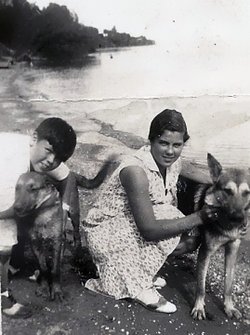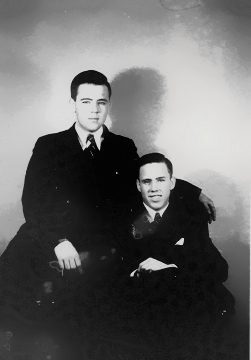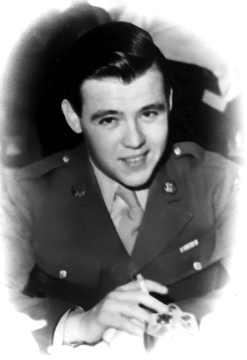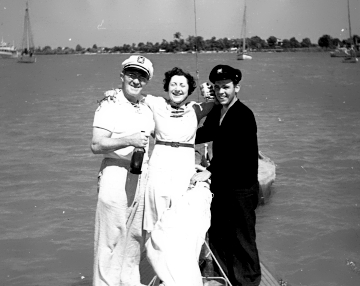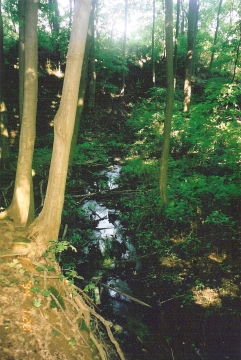During W. W. II, Richard was an officer in the United States Army and served a two year tour of duty in the South Pacific Theatre, including Noumea, Espiritu Santo, Guadalcanal, New Guinea, and the Philippines. Prior to being deployed, he went through basic training at Camp Hahn in Riverside, California and was then stationed at Mount Soledad just outside San Diego, with the 78th Artillery. When Pearl Harbor was attacked, Richard was in La Jolla gathering supplies for his commanding officer. The 78th, along with the unit's artillery, was sent to Long Beach to defend "our shores". They set up camp on Long Beach Boulevard, hoping they would able to ward off surprise attacks by the Japanese.
After Long Beach, Richard was stationed at Fort Mason in San Francisco. He met Barbara Lucille Crawley there and after a rather brief courtship, the two married at the Fort Mason Chapel on New Years Eve, 1942. The previous year, Richard had met Ronald Reagan, a well known and very popular movie actor. Ronald, a Lieutenant in the Air Force, and Richard became good friends and eventually with another friend, they shared an apartment in San Francisco. Richard and Ronald were both assigned to promoting bond sales at large War Bond Rallies. As the war escalated, the military sent them in different directions and they lost contact. Richard and Barbara went to Starkville, Mississippi, where he attended Officer's Candidate School. He served as a class representative for the Fourth Platoon; was a member of The Courts Martial; and graduated May 26, 1943, a 2nd Lieutenant. When discharged from the service in 1946, Richard had attained the rank of Captain.
When Ronald Reagan was elected Governor of California, Richard wrote him a letter and the Governor quickly replied, "...and I do remember those days in the battle of San Francisco very well."
In 1980 when Ronald Reagan was elected President of the United states, he invited Richard and Barbara to his inauguration. Throughout his first term, President Reagan regularly sent them Christmas cards and after being elected to a second term, Richard and Barbara were invited to the inauguration.
Richard made people laugh and he easily filled a room with smiles. Like his wife, Barbara, he never met a stranger and those who crossed his path, knew they had met a "good man". He died on his 82nd birthday, March 11th, and the last person to speak to him that day was his brother-in-law, Richard William Sprung, who shared the same first and middle names and the same birthday.
Richard really adored his growing up years, his siblings, his parents, and the summer days his family spent at their cottage in Kingsville, Ontario, Canada. He put his thoughts in the following essay:
Whenever I hear people say, "There was nothing like the good ol' days", I know what they are talking about. For me it was Wigles Grove. Several hundred acres of land, extending from the highway down to the shores of Lake Erie, and located about two miles from the small resort town of Kingsville, Ontario, Canada. The Grove was the summer home of my family several years before I was born, and I spent twenty-four summers there prior to being drafted into the Army.
The Grove contained only five summer homes, and each were rented by the same families year after year. There were the Pickerings, The Andrews, The Ducks, and the Dixons, all from Windsor, Ontario. Our family of Kraetkes were the only Americans in the Grove, coming each summer from Detroit, Michigan. Wigles Grove was a place of enchantment, filled with beautiful green trees, wild berry bushes, and a flowing creek that started some place back off 16 Mile Road and ending at the beach. The creek was a wonderful place for exploration. At various points the water bubbled over rocks, forming small waterfalls which collected into clear pools here and there. The pools filled with tiny fish, tadpoles, crabs, marvelous creatures meant to be found by small boys and girls. There were occasional bloodsuckers which we were not so anxious to find, as they always clung tenaciously to our tanned skin and were most difficult to pull loose. They terrified us, and we sincerely believed the bloodsuckers would drain our blood, and slowly eat their way beneath our skin until we died an agonizingly, horrible death.
The five summer homes were called cottages, and were constructed for summer living. Our place, though no more elaborate than the rest, had the best location. It sat on the edge of a bluff, some fifty feet above the sandy beach and we could see the Kingsville Harbor about a mile to the West. In an Easterly direction, we could almost view the Harbor of Leamington, nine miles away. A huge gully separated our cottage from the others, and in the gully the creek slowly meandered it's way to the beach, until it met the seemingly endless waters of Lake Erie.
From the front porch of our place, we could see Pelee Island some eighteen miles off in the distance. On a very clear day, it was possible to see across the lake where Perry's Monument stood up over the horizon in Put-In-Bay, sixty miles away. In the evening we loved to sit on the porch and watch the cruise ships named Greater Detroit and Greater Buffalo, make their way from Detroit to Buffalo, New York, and back again. The boats were just silhouettes on the horizon, but as children we waved as they passed by knowing we could not be seen, but always hoping the ship's captain was standing on the bridge with his binoculars trained directly on us as we sat on the porch.
In the middle of The Grove stood a large building known as the pavilion. It was about 100 feet long and 75 feet wide. The tobacco grown by neighboring farmers, was brought to the pavilion and hung from the rafters to dry. What a great place for us kids to play, especially on rainy days. The drying tobacco leaves created many little, darkened rooms in which to get lost for a good game of hide-n-seek. Although the building was always locked, somehow we managed to find entrance into that magical place. We could never lie to our mothers as to our whereabouts, for the dirt covering our faces, hands, and clothing was a dead-give-away.
Once each summer the Pavilion became the scene of a huge costume party. Several days before the festivities, and before the tobacco was taken down, every man, woman, and child who was big enough to wield a broom, mop, or carry a bucket of water, pitched in to clean away the dirt from the huge Pavilion floor. People came from miles around to help get ready for the event. Everyone laughed, joked incessantly with each other, played continuous pranks, and of course there were always the children......oh what a glorious time we had! The actual night of the party was an evening when friendships were formed, and old ones renewed. How well I remember those lazy, dazy summers spent at The Grove......for those were the good ol' days, The time of youth and innocence, when life was easy, and getting old wasn't even a fleeting thought......
Written by Richard William Kraetke Abt. 1976
Taken from his vast resources of childhood memories
*********
My father had two daughters, Jo-Ann Kraetke Utter and his youngest daughter, Susan Kraetke Oldham 1949 - Contributor: Susan Kraetke Oldham (51085050)
During W. W. II, Richard was an officer in the United States Army and served a two year tour of duty in the South Pacific Theatre, including Noumea, Espiritu Santo, Guadalcanal, New Guinea, and the Philippines. Prior to being deployed, he went through basic training at Camp Hahn in Riverside, California and was then stationed at Mount Soledad just outside San Diego, with the 78th Artillery. When Pearl Harbor was attacked, Richard was in La Jolla gathering supplies for his commanding officer. The 78th, along with the unit's artillery, was sent to Long Beach to defend "our shores". They set up camp on Long Beach Boulevard, hoping they would able to ward off surprise attacks by the Japanese.
After Long Beach, Richard was stationed at Fort Mason in San Francisco. He met Barbara Lucille Crawley there and after a rather brief courtship, the two married at the Fort Mason Chapel on New Years Eve, 1942. The previous year, Richard had met Ronald Reagan, a well known and very popular movie actor. Ronald, a Lieutenant in the Air Force, and Richard became good friends and eventually with another friend, they shared an apartment in San Francisco. Richard and Ronald were both assigned to promoting bond sales at large War Bond Rallies. As the war escalated, the military sent them in different directions and they lost contact. Richard and Barbara went to Starkville, Mississippi, where he attended Officer's Candidate School. He served as a class representative for the Fourth Platoon; was a member of The Courts Martial; and graduated May 26, 1943, a 2nd Lieutenant. When discharged from the service in 1946, Richard had attained the rank of Captain.
When Ronald Reagan was elected Governor of California, Richard wrote him a letter and the Governor quickly replied, "...and I do remember those days in the battle of San Francisco very well."
In 1980 when Ronald Reagan was elected President of the United states, he invited Richard and Barbara to his inauguration. Throughout his first term, President Reagan regularly sent them Christmas cards and after being elected to a second term, Richard and Barbara were invited to the inauguration.
Richard made people laugh and he easily filled a room with smiles. Like his wife, Barbara, he never met a stranger and those who crossed his path, knew they had met a "good man". He died on his 82nd birthday, March 11th, and the last person to speak to him that day was his brother-in-law, Richard William Sprung, who shared the same first and middle names and the same birthday.
Richard really adored his growing up years, his siblings, his parents, and the summer days his family spent at their cottage in Kingsville, Ontario, Canada. He put his thoughts in the following essay:
Whenever I hear people say, "There was nothing like the good ol' days", I know what they are talking about. For me it was Wigles Grove. Several hundred acres of land, extending from the highway down to the shores of Lake Erie, and located about two miles from the small resort town of Kingsville, Ontario, Canada. The Grove was the summer home of my family several years before I was born, and I spent twenty-four summers there prior to being drafted into the Army.
The Grove contained only five summer homes, and each were rented by the same families year after year. There were the Pickerings, The Andrews, The Ducks, and the Dixons, all from Windsor, Ontario. Our family of Kraetkes were the only Americans in the Grove, coming each summer from Detroit, Michigan. Wigles Grove was a place of enchantment, filled with beautiful green trees, wild berry bushes, and a flowing creek that started some place back off 16 Mile Road and ending at the beach. The creek was a wonderful place for exploration. At various points the water bubbled over rocks, forming small waterfalls which collected into clear pools here and there. The pools filled with tiny fish, tadpoles, crabs, marvelous creatures meant to be found by small boys and girls. There were occasional bloodsuckers which we were not so anxious to find, as they always clung tenaciously to our tanned skin and were most difficult to pull loose. They terrified us, and we sincerely believed the bloodsuckers would drain our blood, and slowly eat their way beneath our skin until we died an agonizingly, horrible death.
The five summer homes were called cottages, and were constructed for summer living. Our place, though no more elaborate than the rest, had the best location. It sat on the edge of a bluff, some fifty feet above the sandy beach and we could see the Kingsville Harbor about a mile to the West. In an Easterly direction, we could almost view the Harbor of Leamington, nine miles away. A huge gully separated our cottage from the others, and in the gully the creek slowly meandered it's way to the beach, until it met the seemingly endless waters of Lake Erie.
From the front porch of our place, we could see Pelee Island some eighteen miles off in the distance. On a very clear day, it was possible to see across the lake where Perry's Monument stood up over the horizon in Put-In-Bay, sixty miles away. In the evening we loved to sit on the porch and watch the cruise ships named Greater Detroit and Greater Buffalo, make their way from Detroit to Buffalo, New York, and back again. The boats were just silhouettes on the horizon, but as children we waved as they passed by knowing we could not be seen, but always hoping the ship's captain was standing on the bridge with his binoculars trained directly on us as we sat on the porch.
In the middle of The Grove stood a large building known as the pavilion. It was about 100 feet long and 75 feet wide. The tobacco grown by neighboring farmers, was brought to the pavilion and hung from the rafters to dry. What a great place for us kids to play, especially on rainy days. The drying tobacco leaves created many little, darkened rooms in which to get lost for a good game of hide-n-seek. Although the building was always locked, somehow we managed to find entrance into that magical place. We could never lie to our mothers as to our whereabouts, for the dirt covering our faces, hands, and clothing was a dead-give-away.
Once each summer the Pavilion became the scene of a huge costume party. Several days before the festivities, and before the tobacco was taken down, every man, woman, and child who was big enough to wield a broom, mop, or carry a bucket of water, pitched in to clean away the dirt from the huge Pavilion floor. People came from miles around to help get ready for the event. Everyone laughed, joked incessantly with each other, played continuous pranks, and of course there were always the children......oh what a glorious time we had! The actual night of the party was an evening when friendships were formed, and old ones renewed. How well I remember those lazy, dazy summers spent at The Grove......for those were the good ol' days, The time of youth and innocence, when life was easy, and getting old wasn't even a fleeting thought......
Written by Richard William Kraetke Abt. 1976
Taken from his vast resources of childhood memories
*********
My father had two daughters, Jo-Ann Kraetke Utter and his youngest daughter, Susan Kraetke Oldham 1949 - Contributor: Susan Kraetke Oldham (51085050)
